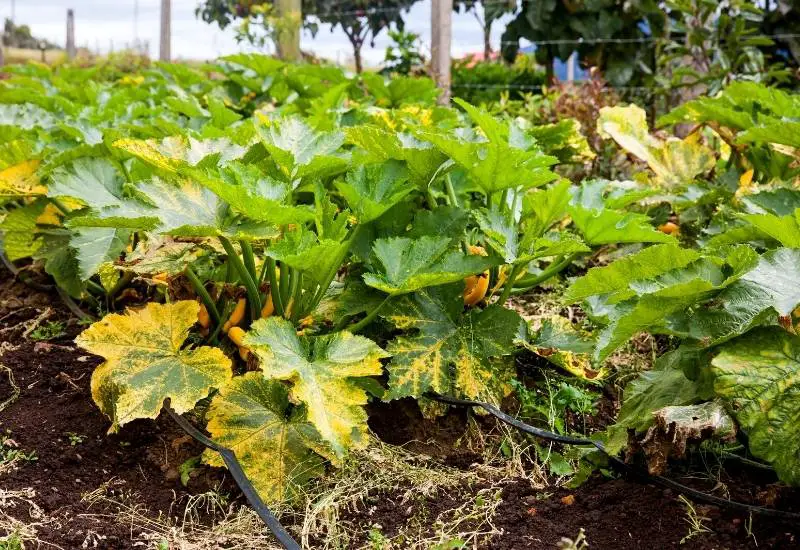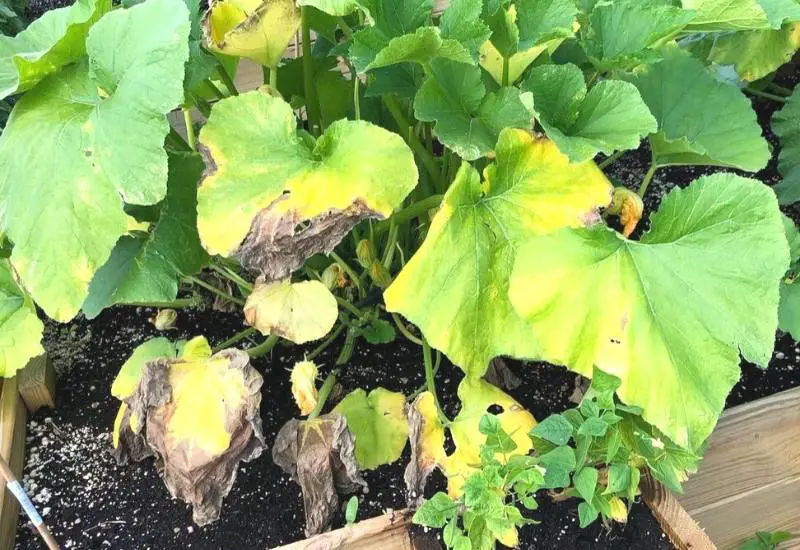You’re a gardening enthusiast, thrilled to witness the growth of your zucchini plants in your backyard. However, amidst your excitement, you notice a concerning change – the lush green leaves of your beloved zucchini plants are gradually turning a vibrant yellow. You stand there and ask to yourself Why are my zucchini plants turning yellow? What could possibly be the reason behind this transformation? Stay tuned to uncover the mystery behind why your zucchini plants are turning yellow and discover some simple solutions to bring back their natural, healthy green hue.
Possible Causes for Yellowing Zucchini Plants
Zucchini plants are renowned for their vibrant green leaves and abundant production of delicious squash. However, if you notice that your zucchini plants are turning yellow, it could be an indication that something is amiss. Several factors can contribute to the yellowing of zucchini plants, including insufficient sunlight, inadequate water, poor soil conditions, pest infestations, diseases, nutrient deficiencies, temperature stress, over-fertilization, the natural aging process, and improper pruning techniques. In this article, we will explore each of these possible causes in detail and provide you with practical solutions to help you identify and treat the underlying issues.
Insufficient Sunlight
Effects of Insufficient Sunlight on Zucchini Plants
Zucchini plants thrive on sunlight. They require a minimum of six to eight hours of direct sunlight each day to thrive and maintain their lush green color. When zucchini plants do not receive adequate sunlight, their leaves may start to turn yellow. This is because sunlight plays a crucial role in photosynthesis, the process through which plants convert sunlight into energy. Without enough sunlight, the plants struggle to produce the energy they need to grow and maintain healthy green foliage.
Increasing Sunlight Exposure
If you suspect that insufficient sunlight is the cause of your yellowing zucchini plants, there are several steps you can take to increase their exposure to sunlight. Start by carefully assessing the location of your zucchini plants. If they are growing in a shaded area, consider relocating them to a sunnier spot in your garden. Additionally, you can prune nearby trees or large plants that may be casting shadows on your zucchini plants. By allowing more sunlight to reach the plants, you can help them regain their vibrant green color and ensure their overall health and productivity.

Inadequate Water
Effects of Inadequate Water on Zucchini Plants
Proper watering is essential for the health and growth of zucchini plants. Insufficient water can cause the leaves of the plants to turn yellow as they struggle to retain moisture. Inadequate water supply can also lead to stunted growth, wilting, and a decrease in overall productivity. It’s important to note that both underwatering and overwatering can contribute to the yellowing of zucchini plants. Therefore, finding the right balance is crucial to maintaining their health.
Proper Watering Techniques for Zucchini Plants
To ensure that your zucchini plants receive adequate water, it is important to follow proper watering techniques. The key is to provide consistent moisture without overwatering. Start by checking the soil moisture regularly by inserting your finger into the soil up to the first knuckle. If the soil feels dry at this depth, it’s time to water. When watering, apply water directly to the base of the plants, avoiding wetting the leaves. Deep watering is preferable, allowing the water to penetrate deeper into the soil and encourage the roots to grow downward. Mulching around the plants can also help retain moisture and reduce the frequency of watering. By following these techniques, you can help prevent yellowing due to inadequate water supply and promote healthy growth in your zucchini plants.
Poor Soil Conditions
Effects of Poor Soil Conditions on Zucchini Plants
The quality of the soil in which your zucchini plants are growing plays a significant role in their overall health and vitality. Poor soil conditions, such as compacted soil, soil with improper pH levels, or soil lacking essential nutrients, can cause the leaves of zucchini plants to turn yellow. Nutrient deficiencies prevent plants from obtaining the necessary minerals for optimal growth, while compacted soil impedes root development and the absorption of nutrients and water.
Amending and Improving Soil for Zucchini Plants
To address poor soil conditions and prevent yellowing in zucchini plants, consider amending the soil. Start by performing a soil test to identify any deficiencies in nutrients and adjust the pH level accordingly. Based on the soil test results, you can add organic matter, such as compost or well-rotted manure, to improve soil structure and fertility. This will enhance nutrient availability and water retention, ensuring that your zucchini plants receive the essential elements for healthy growth. Additionally, loosening compacted soil with a garden fork or tiller can create a better environment for root development and alleviate drainage issues. By taking steps to improve the soil conditions, you can help your zucchini plants overcome yellowing and thrive in your garden.

Pest Infestations
Common Pests Affecting Zucchini Plants
Pests can wreak havoc on zucchini plants, leading to yellowing of the leaves and severe damage if left untreated. Some common pests that affect zucchini plants include aphids, squash bugs, cucumber beetles, and spider mites. These insects feed on the leaves, sap, or fruits of the plants, causing stress and nutrient loss. As a result, the affected leaves may turn yellow and develop feeding damage.
Identifying and Controlling Pests on Zucchini Plants
To identify and control pests on your zucchini plants, regularly inspect the leaves, stems, and fruits for any signs of infestation. Look for visible pests, their eggs, or feeding damage. If you discover any pests, promptly remove them by hand or apply organic pest control methods, such as insecticidal soap or neem oil. Introducing beneficial insects, like ladybugs or lacewings, can also help keep pest populations in check. By practicing regular pest monitoring and employing appropriate pest control measures, you can minimize the risk of yellowing due to pest infestations and protect the overall health of your zucchini plants.
Diseases
Common Diseases Affecting Zucchini Plants
Like any other plants, zucchini plants are susceptible to diseases, which can cause their leaves to yellow and affect their overall growth and productivity. Common diseases that can affect zucchini plants include powdery mildew, bacterial wilt, downy mildew, and fusarium wilt. These diseases are typically caused by fungal or bacterial pathogens and can spread rapidly, especially in humid and moist environments.
Preventing and Treating Diseases in Zucchini Plants
Prevention is key when it comes to managing diseases in zucchini plants. Start by choosing disease-resistant varieties, as they are less susceptible to infections. Ensure proper spacing between plants to promote good air circulation and reduce the likelihood of fungal growth. Additionally, avoid overhead watering and opt for drip irrigation to keep the foliage dry. Regularly inspect your plants for early signs of disease, such as yellow spots or powdery growth, and promptly remove and destroy affected plant parts to prevent further spread. Applying organic fungicides or bactericides labeled for use on zucchini plants can also help control disease progression. By implementing preventive measures and taking swift action when necessary, you can effectively manage diseases and maintain the vitality of your zucchini plants.

Nutrient Deficiencies
Common Nutrient Deficiencies in Zucchini Plants
Nutrient deficiencies can have a significant impact on the health and color of zucchini plants. Common nutrient deficiencies that can cause yellowing of the leaves include nitrogen, phosphorus, potassium, magnesium, and iron deficiencies. Each nutrient plays a crucial role in various aspects of plant growth and development. When deficient, zucchini plants may exhibit yellowing leaves, stunted growth, and reduced fruit production.
Soil Testing and Fertilization for Zucchini Plants
To address nutrient deficiencies in zucchini plants, it is essential to perform a soil test. Soil testing can provide valuable insights into the nutrient levels present in your soil and help you determine the appropriate fertilizer amendments. Based on the soil test results, you can apply a balanced fertilizer or specific nutrient amendments to correct deficiencies. Organic fertilizers, such as compost or well-rotted manure, can also be beneficial in improving soil fertility and providing a slow-release source of nutrients for the plants. Regular fertilization, following the recommended guidelines for zucchini plants, will help ensure they receive the necessary nutrients to thrive and prevent the occurrence of yellowing.
Temperature Stress
Effects of Temperature Stress on Zucchini Plants
Exposure to extreme temperatures can stress zucchini plants, affecting their physiological processes and leading to yellowing of the leaves. High temperatures can cause heat stress, while cold temperatures can induce chilling stress. Both can disrupt photosynthesis, impair nutrient uptake, and hinder plant growth and development, resulting in yellowing leaves.
Managing Temperature Stress in Zucchini Plants
To manage temperature stress and prevent yellowing in zucchini plants, it is crucial to provide appropriate growing conditions. In areas with high temperatures, providing shade using shade cloth or planting zucchini in a spot with afternoon shade can help mitigate the effects of excessive heat. In colder regions, consider using row covers or cloches to protect the plants from low temperatures. Additionally, practicing proper watering techniques and enhancing soil health can improve the plants’ resilience to temperature stress. By providing a favorable environment, you can help your zucchini plants withstand temperature extremes and maintain their vibrant green color.

Over-Fertilization
Effects of Over-Fertilization on Zucchini Plants
Although fertilizers are essential for plant growth, over-fertilization can be detrimental to zucchini plants. Excessive application of fertilizers, especially those high in nitrogen, can cause leaf yellowing. This yellowing, known as nitrogen toxicity, occurs when the plants receive an excess of nitrogen compared to other essential nutrients. Over-fertilization can also lead to nutrient imbalances, affecting the plants’ overall health and productivity.
Adjusting Fertilization Practices
To prevent yellowing due to over-fertilization, it is important to follow appropriate fertilization practices. Start by determining the nutrient requirements of zucchini plants based on soil testing and the specific needs of your soil. This will help you determine the correct fertilizer type and application rate. Apply fertilizers according to the recommended guidelines, avoiding excessive use. Consider organic fertilizers that release nutrients slowly, reducing the risk of nutrient overload and helping maintain a balanced nutrient profile in the soil. Proper fertilization practices will promote healthy growth and minimize the occurrence of yellowing in your zucchini plants.
Natural Aging Process
Effects of the Natural Aging Process on Zucchini Plants
Similar to other living organisms, zucchini plants go through a natural aging process. As the plants mature and produce fruits, older leaves gradually yellow and die off. This is a normal part of the plant’s life cycle and does not necessarily indicate a problem unless the yellowing occurs rapidly or affects a large number of leaves simultaneously.
Harvesting at the Right Time
To distinguish between natural aging and other causes of yellowing, it is important to observe the pattern and extent of the leaf yellowing. If the yellowing is limited to the older leaves at the base of the plant while the newer leaves remain green, it is likely part of the natural aging process. In such cases, continue to care for your zucchini plants with regular watering, fertilization, and pest control measures. When harvesting, ensure that you pick zucchinis at the right time, before they become overly mature and decline in quality. By understanding the natural aging process and proper harvest timing, you can effectively manage and enjoy a bountiful zucchini harvest.
Improper Pruning Techniques
Effects of Improper Pruning on Zucchini Plants
Pruning is an important practice that helps maintain the shape, size, and overall health of zucchini plants. However, improper pruning techniques can cause yellowing of the leaves and impact the plant’s growth and productivity. Excessive pruning can remove too many leaves, reducing the plant’s ability to produce energy through photosynthesis. On the other hand, insufficient pruning can result in overcrowding, poor air circulation, and increased susceptibility to disease and pest infestations.
Proper Techniques for Pruning Zucchini Plants
To avoid yellowing caused by improper pruning, it is essential to follow proper techniques. Start by removing any damaged, dead, or diseased branches or leaves using clean pruning shears. This will help maintain a clean and healthy growing environment for your zucchini plants. Additionally, thin out the plant by selectively removing some of the larger leaves and branches, promoting good air circulation and light penetration. Regularly monitor the growth of your zucchini plants and adjust pruning as needed to maintain an optimal balance between foliage and fruit production. By practicing proper pruning techniques, you can keep your zucchini plants healthy, vigorous, and free from unnecessary leaf yellowing.
In conclusion, yellowing zucchini plants can be caused by a variety of factors, ranging from environmental conditions to nutrient deficiencies or pests and diseases. By identifying the specific cause of yellowing and implementing targeted treatments, you can restore the health and vitality of your zucchini plants. Remember to provide sufficient sunlight, appropriate watering, and suitable soil conditions. Be vigilant about pest control and disease prevention, conduct regular soil testing and fertilization, manage temperature stress, and practice proper pruning techniques. With these strategies in place, you can enjoy a thriving zucchini garden and a bountiful harvest of delicious squash. Happy gardening!



